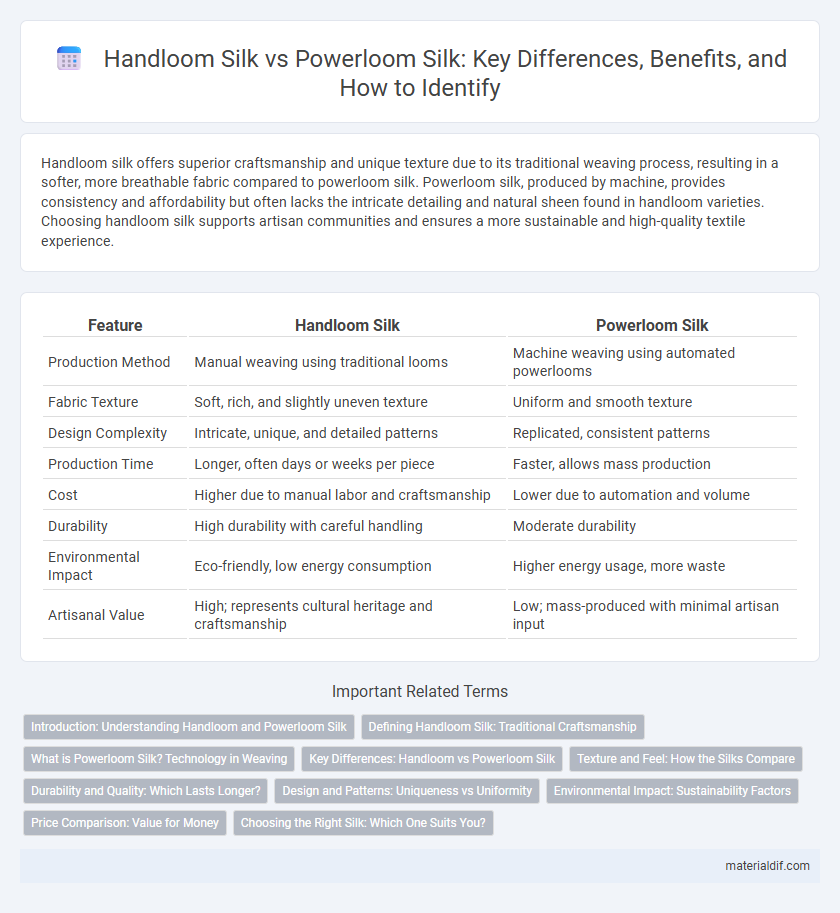Handloom silk offers superior craftsmanship and unique texture due to its traditional weaving process, resulting in a softer, more breathable fabric compared to powerloom silk. Powerloom silk, produced by machine, provides consistency and affordability but often lacks the intricate detailing and natural sheen found in handloom varieties. Choosing handloom silk supports artisan communities and ensures a more sustainable and high-quality textile experience.
Table of Comparison
| Feature | Handloom Silk | Powerloom Silk |
|---|---|---|
| Production Method | Manual weaving using traditional looms | Machine weaving using automated powerlooms |
| Fabric Texture | Soft, rich, and slightly uneven texture | Uniform and smooth texture |
| Design Complexity | Intricate, unique, and detailed patterns | Replicated, consistent patterns |
| Production Time | Longer, often days or weeks per piece | Faster, allows mass production |
| Cost | Higher due to manual labor and craftsmanship | Lower due to automation and volume |
| Durability | High durability with careful handling | Moderate durability |
| Environmental Impact | Eco-friendly, low energy consumption | Higher energy usage, more waste |
| Artisanal Value | High; represents cultural heritage and craftsmanship | Low; mass-produced with minimal artisan input |
Introduction: Understanding Handloom and Powerloom Silk
Handloom silk is crafted using traditional weaving techniques where artisans manually operate the loom, resulting in unique textures and intricate patterns that reflect cultural heritage. Powerloom silk is produced using mechanized looms that enable faster, mass production with more uniform fabric quality and lower cost. Understanding the differences between handloom and powerloom silk involves recognizing the artisanal value, production scale, and texture variations inherent in each method.
Defining Handloom Silk: Traditional Craftsmanship
Handloom silk is characterized by its traditional craftsmanship, where skilled artisans manually weave silk threads on wooden handlooms, preserving age-old techniques. This labor-intensive process results in unique textures and intricate patterns, offering superior quality and cultural value compared to powerloom silk. The slow, meticulous weaving imparts a distinct sheen and durability, making handloom silk a prized fabric in luxury textiles.
What is Powerloom Silk? Technology in Weaving
Powerloom silk is produced using mechanized looms that automate the weaving process, significantly increasing fabric production speed compared to traditional handloom methods. This technology employs electric motors to drive the shuttle movement, creating consistent, uniform patterns while reducing manual labor and time. Powerloom weaving also allows for large-scale manufacturing, making silk fabrics more accessible and affordable in the textile market.
Key Differences: Handloom vs Powerloom Silk
Handloom silk is crafted manually on traditional looms, resulting in unique textures and intricate designs that reflect skilled artisanal work. Powerloom silk, produced using mechanized looms, offers consistent patterns and faster production suitable for mass manufacturing. The key differences lie in handloom silk's superior breathability and craftsmanship versus powerloom silk's uniformity and cost-efficiency.
Texture and Feel: How the Silks Compare
Handloom silk features a rich, uneven texture with a natural sheen, offering a softer, more breathable feel due to traditional weaving techniques that preserve the fiber's integrity. Powerloom silk, produced by mechanized weaving, tends to have a more uniform texture with a smoother surface, but often lacks the depth and unique tactile qualities found in handloom variants. The subtle irregularities in handloom silk contribute to its distinctive charm and luxurious feel, making it preferred for high-end and artisanal silk products.
Durability and Quality: Which Lasts Longer?
Handloom silk showcases superior durability and quality due to the meticulous weaving process that produces tightly bound fibers, resulting in a fabric that lasts significantly longer than powerloom silk. Powerloom silk, although faster and more uniform in production, often lacks the strength and richness found in handloom varieties, making it prone to wear and tear over time. The intricate craftsmanship of handloom silk contributes to its resilience and luxurious texture, ensuring longevity that powerloom silk rarely achieves.
Design and Patterns: Uniqueness vs Uniformity
Handloom silk offers intricate and unique designs, reflecting artisan craftsmanship with each piece showcasing subtle variations in patterns and textures. Powerloom silk produces more uniform and consistent patterns, ideal for mass production but often lacking the distinct character found in handwoven fabrics. The choice between them depends on valuing the individuality and cultural heritage of handloom versus the efficiency and precision of powerloom designs.
Environmental Impact: Sustainability Factors
Handloom silk production significantly reduces environmental impact by relying on manual weaving processes that consume less energy and produce minimal waste compared to powerloom silk. Powerloom silk often involves higher electricity usage and faster production rates, leading to increased carbon emissions and resource depletion. Sustainable handloom practices support eco-friendly craftsmanship, preserve traditional skills, and promote lower ecological footprints in the textile industry.
Price Comparison: Value for Money
Handloom silk typically commands a higher price due to its intricate craftsmanship, limited production, and superior texture, providing exceptional value for connoisseurs seeking authenticity. Powerloom silk, being mass-produced, offers a more affordable alternative with consistent quality, appealing to budget-conscious consumers. The price difference reflects the balance between artisanal uniqueness in handloom pieces and the cost-efficiency of powerloom silk.
Choosing the Right Silk: Which One Suits You?
Handloom silk offers unique texture, intricate patterns, and artisanal craftsmanship, making it ideal for those valuing tradition and originality in their fabric choice. Powerloom silk provides uniformity, quicker production, and affordability, suited for customers seeking consistency and cost-effectiveness. Selecting between handloom and powerloom silk depends on prioritizing heritage and exclusivity versus efficiency and budget.
Handloom Silk vs Powerloom Silk Infographic

 materialdif.com
materialdif.com